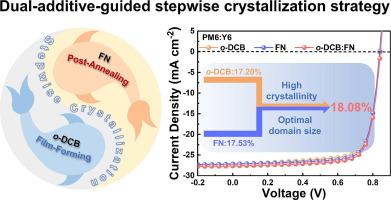Temporally stepwise crystallization via dual-additive orchestration: resolving the crystallinity-domain size paradox for high-efficiency organic photovoltaics
IF 14.9
1区 化学
Q1 Energy
引用次数: 0
Abstract
Achieving simultaneous enhancement of crystallinity and optimal domain size remains a fundamental challenge in organic photovoltaics (OPVs), where conventional crystallization strategies often trigger excessive aggregation of small-molecule acceptors. This work pioneers a kinetic paradigm for resolving the crystallinity-domain size trade-off in organic photovoltaics through dual-additive-guided stepwise crystallization. By strategically pairing 1,2-dichlorobenzene (o-DCB, low binding energy to Y6) and 1-fluoronaphthalene (FN, high binding energy), we achieve temporally decoupled crystallization control: o-DCB first mediates donor-acceptor co-crystallization during film formation, constructing a metastable network, whereupon FN induces confined Y6 crystallization within this framework during thermal annealing, refining nanostructure without over-aggregation. Morphology studies reveal that this synergy enhances crystallinity of (100) diffraction peaks by 21 %–10 % versus single-additive controls (o-DCB/FN alone), while maintaining optimal domain size. These morphological advantages yield balanced carrier transport (μh/μe = 1.23), near-unity exciton dissociation (98.53 %), and a champion power conversion efficiency (PCE) of 18.08 % for PM6:Y6, significantly surpassing single-additive devices (o-DCB: 17.20 %; FN: 17.53 %). Crucially, the dual-additive strategy demonstrates universal applicability across diverse active layer systems, achieving an outstanding PCE of 19.27 % in PM6:L8-BO-based devices, thereby establishing a general framework for morphology control in high-efficiency OPVs.

通过双加性编排的时间逐步结晶:解决高效有机光伏的结晶-畴尺寸悖论
实现同时增强结晶度和最佳结构域尺寸仍然是有机光伏(opv)的一个基本挑战,传统的结晶策略经常引发小分子受体的过度聚集。这项工作开创了一种动力学范式,通过双添加剂引导的逐步结晶来解决有机光伏电池中结晶-畴尺寸的权衡。通过策略性配对1,2-二氯苯(o-DCB,对Y6的低结合能)和1-氟萘(FN,高结合能),我们实现了暂时解耦的结晶控制:o-DCB首先在薄膜形成过程中介导供体-受体共结晶,构建亚稳态网络,然后FN在热退火过程中在该框架内诱导受限的Y6结晶,精炼纳米结构而不会过度聚集。形态学研究表明,与单一添加剂对照(o-DCB/FN单独)相比,这种协同作用使(100)衍射峰的结晶度提高了21% - 10%,同时保持了最佳的结构域大小。这些形态优势使PM6:Y6的载流子输运平衡(μh/μe = 1.23),激子解离接近统一(98.53%),功率转换效率(PCE)达到18.08%,显著优于单添加剂器件(o-DCB: 17.20%; FN: 17.53%)。重要的是,双添加剂策略在不同有源层系统中具有普遍适用性,在基于PM6: l8 - bo的器件中实现了19.27%的PCE,从而为高效opv的形态控制建立了一个总体框架。
本文章由计算机程序翻译,如有差异,请以英文原文为准。
求助全文
约1分钟内获得全文
求助全文
来源期刊

Journal of Energy Chemistry
CHEMISTRY, APPLIED-CHEMISTRY, PHYSICAL
CiteScore
19.10
自引率
8.40%
发文量
3631
审稿时长
15 days
期刊介绍:
The Journal of Energy Chemistry, the official publication of Science Press and the Dalian Institute of Chemical Physics, Chinese Academy of Sciences, serves as a platform for reporting creative research and innovative applications in energy chemistry. It mainly reports on creative researches and innovative applications of chemical conversions of fossil energy, carbon dioxide, electrochemical energy and hydrogen energy, as well as the conversions of biomass and solar energy related with chemical issues to promote academic exchanges in the field of energy chemistry and to accelerate the exploration, research and development of energy science and technologies.
This journal focuses on original research papers covering various topics within energy chemistry worldwide, including:
Optimized utilization of fossil energy
Hydrogen energy
Conversion and storage of electrochemical energy
Capture, storage, and chemical conversion of carbon dioxide
Materials and nanotechnologies for energy conversion and storage
Chemistry in biomass conversion
Chemistry in the utilization of solar energy
 求助内容:
求助内容: 应助结果提醒方式:
应助结果提醒方式:


